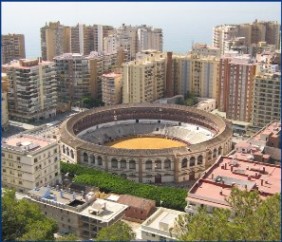 Málaga, with its 600.000 inhabitants, is the second largest city of Andalusia and a genuine and typical Andalusian city. It is a thriving Mediterranean seaport at the center of the Costa del Sol in southern Spain, near by Gibraltar. Málaga, with its 600.000 inhabitants, is the second largest city of Andalusia and a genuine and typical Andalusian city. It is a thriving Mediterranean seaport at the center of the Costa del Sol in southern Spain, near by Gibraltar.The city was first called MALACA (probably from the word malac - to salt) by the Phoenicians who landed there, 3,000 years ago. The harbor was used as an important center for salting fish, and trading port on the Iberian Peninsula. Malaca was at various times a Carthaginian, Roman, and Moorish colony. Under the Romans and the Moors, it developed into a strong military station. Rome's victory against Carthage, in 206 BC, made it a major port for Roman trade with Byzantium. It later fell to the Moors in 711 and became their main port serving Granada until the mid fifteenth century. In 1487, Spanish Christians recaptured it after a heroic and bloody resistance. The Moors who stayed behind were expelled after a rebellion. |
||
 Malaga's illustrious past has left its print on the historic center, with countless Moorish remains, as well as, a Roman amphitheater, the 12th-century Moorish fortress Alcazaba, a Muslim Fort, and the ruins of a Moorish castle on Mount Gibralfaro. The area radiates with the 16th-century Cathedral (note the wood carvings), which now houses the Museum of Fine Arts. It has a half-built second tower which was abandoned in 1765 when the funds ran out, thus, the reason for the cathedral's nickname: La Maquita (the one-armed one). It's also worth visiting the impressive park in the Calle de Alameda with one of the most celebrated botanical Malaga's illustrious past has left its print on the historic center, with countless Moorish remains, as well as, a Roman amphitheater, the 12th-century Moorish fortress Alcazaba, a Muslim Fort, and the ruins of a Moorish castle on Mount Gibralfaro. The area radiates with the 16th-century Cathedral (note the wood carvings), which now houses the Museum of Fine Arts. It has a half-built second tower which was abandoned in 1765 when the funds ran out, thus, the reason for the cathedral's nickname: La Maquita (the one-armed one). It's also worth visiting the impressive park in the Calle de Alameda with one of the most celebrated botanical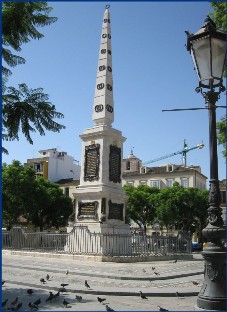 collections in Europe. collections in Europe.Málaga's Museo de Bellas Artes has several fine paintings by Murillo, Ribera, Zurbaran and Morales, and a number of childhood sketches by Pablo Picasso. Picasso's house in Plaza Merced, where the famous painter and sculptor was born, has been turned into a historic building -- The Museum Picasso. It contains a large collection of the artist's engravings and archives of his life and works. Pablo Picasso is the city's famous son and there are several galleries showing his work. Málaga is the Andalusian city with the most cosmopolitan character. It is primarily a commercial city and a hub for transport. By car, bus or train, you can easily reach Evilla, Seville, Granada, Madrid, Benalmadena, Córdoba and Cadiz. Even Portugal and Morocco can be reached within a few hours. |
||
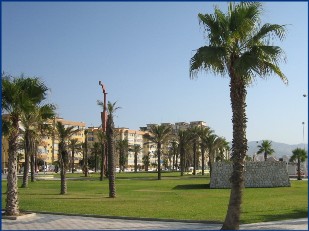 Yet the city is also known for its extraordinary mild climate, with an average temperature throughout the year of about 22 degrees Celsius and 330 sunny Mediterranean days. Up until the mild months of winter, you can enjoy sitting outside on the terraces at its many beaches. The city attracts students, professionals and scholars from around the globe. It offers unlimited leisure time activities. Sports fans will find top-rate facilities for golf, water sports, horseback riding, and skiing all within close reach. Yet the city is also known for its extraordinary mild climate, with an average temperature throughout the year of about 22 degrees Celsius and 330 sunny Mediterranean days. Up until the mild months of winter, you can enjoy sitting outside on the terraces at its many beaches. The city attracts students, professionals and scholars from around the globe. It offers unlimited leisure time activities. Sports fans will find top-rate facilities for golf, water sports, horseback riding, and skiing all within close reach.The beaches in Málaga are generally on the touristy side, thus, you will find them very crowded. However, the Costa del Sol offers numerous and magnificently well kept beaches that stretch both to the west and east. The eastern beaches are rockier and marginally less developed than the western beaches. Nerja, a typical fisherman town surrounded by tourist pueblos, is located in this area. Westward, the coast is highly developed: Torremolinos, Fuengirola and Estepona are appealing resorts with clean sandy beaches, a wide choice of hotels and restaurants and unparalleled variety of entertainment. Marbella is a luxurious resort. The ultimate in coastal charisma is Marbella's Puerto Banus, it's the place to be pampered and relax. |
||
 The city sparkles year-round because of its temperament. This temperament is best illustrated in the folklore of Málaga: the Flamenco song and dance. Before and during Easter there are numerous festivities that show Malaga in its entire splendor, a joy to behold. During the summer, the "locos veranos" ("crazy summers") at its beaches, are famous in all of Spain. All year round, Malaga features a thriving nightlife - you'll find everything from flamenco performances and hospitable tapas bars to modern nightclubs and discos. Locals and tourists alike, leave home around midnight and cruise the bars and clubs till dawn. An ideal starting-point for a night-out is the beautiful seaside promenade of El Palo with its many fish-restaurants and fashionable hangout The city sparkles year-round because of its temperament. This temperament is best illustrated in the folklore of Málaga: the Flamenco song and dance. Before and during Easter there are numerous festivities that show Malaga in its entire splendor, a joy to behold. During the summer, the "locos veranos" ("crazy summers") at its beaches, are famous in all of Spain. All year round, Malaga features a thriving nightlife - you'll find everything from flamenco performances and hospitable tapas bars to modern nightclubs and discos. Locals and tourists alike, leave home around midnight and cruise the bars and clubs till dawn. An ideal starting-point for a night-out is the beautiful seaside promenade of El Palo with its many fish-restaurants and fashionable hangout s. Another area to consider is La Malagueta, a more modern part of the town, with several fashionable hangouts for young people. While the Pedragalejo area offers many of the most fashionable pubs in town, plus traditional bars and restaurants to enjoy classical Andalusian dishes. s. Another area to consider is La Malagueta, a more modern part of the town, with several fashionable hangouts for young people. While the Pedragalejo area offers many of the most fashionable pubs in town, plus traditional bars and restaurants to enjoy classical Andalusian dishes.The typically Andalusian tapas bars are generally the focal point for the city's nightlife. Don't forget to try the "pescaito frito" and tapas. Plus, the countless cozy bodega bars (wine cellar) in the old town are just the place to have a taste of Malaga's wine. |
||
| In Malaga, you will be able to meet many people and immerse yourself in the local culture, and enjoy the beautiful weather. It is ideal, if you wish to combine sun, sea, temperament and folklore with your travels. | ||
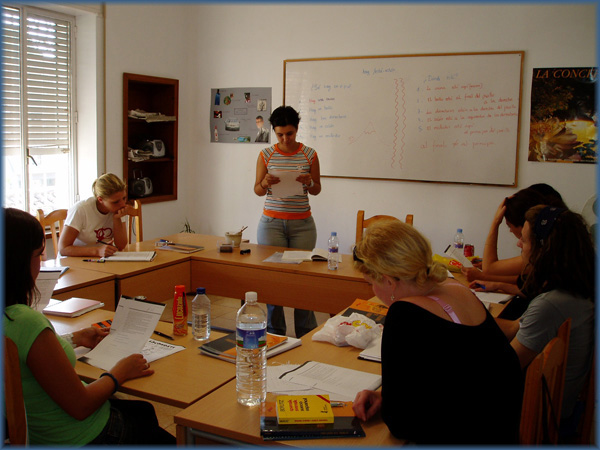 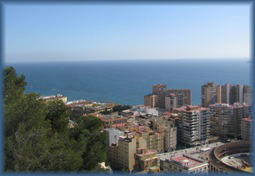 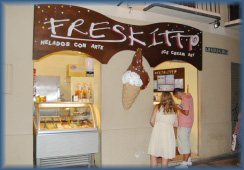 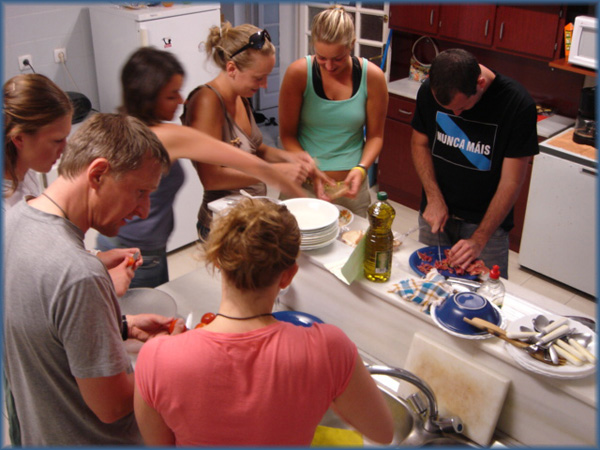 |
||
| School Facilities | ||
|
Instituto Alhambra Centre: is located near the beach in one of the capital’s residential areas. From h |
||
| Bildungsurlaub - CSN - CEELE- EAQUALS- ALTO - AEEA -FEDELE -ELITE - EAIE | ||
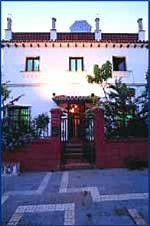 ere, you have easy access to the commercial center, the castle, the alcazaba, the port, marina's square, the cathedral and all the important monuments of Malaga. The building is modern and all its fully
equipped classrooms are also air-conditioned. There is a language laboratory, a free access internet laboratory, and a cinema room where Spanish films are shown throughout the week.
ere, you have easy access to the commercial center, the castle, the alcazaba, the port, marina's square, the cathedral and all the important monuments of Malaga. The building is modern and all its fully
equipped classrooms are also air-conditioned. There is a language laboratory, a free access internet laboratory, and a cinema room where Spanish films are shown throughout the week.